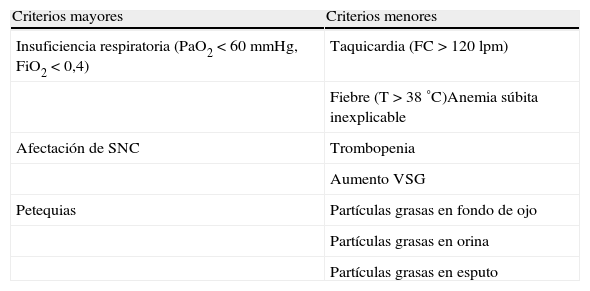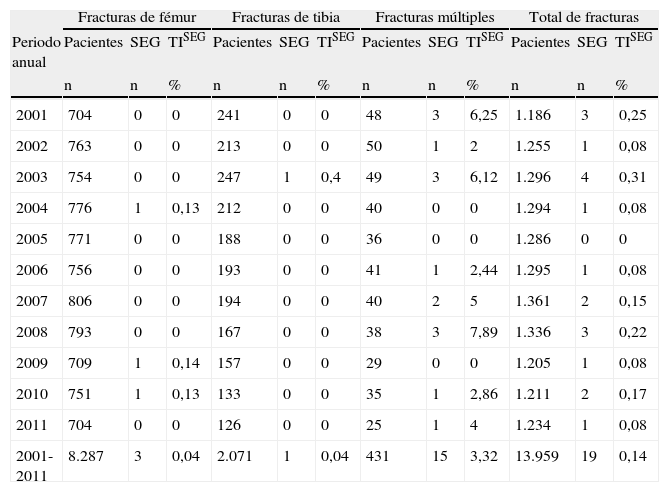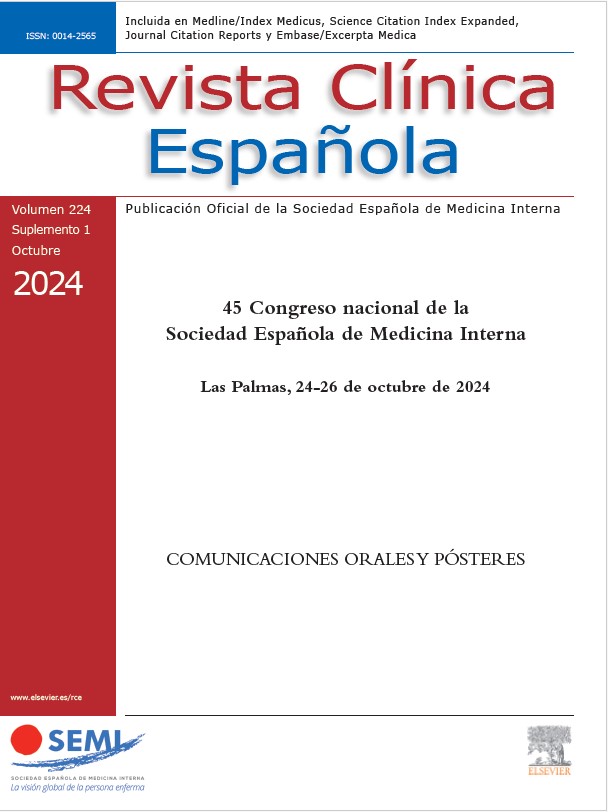Revisar la incidencia, las características clínicas, diagnósticas y terapéuticas, así como la mortalidad del síndrome de embolia grasa (SEG) en la última década.
Pacientes y métodosEstudio retrospectivo y descriptivo de los pacientes diagnosticados de SEG postraumático entre enero de 2001 y diciembre de 2011 en un solo centro.
ResultadosSe evalúan 19 pacientes, 16 varones y 3 mujeres, con edad media de 27 años. Todos presentaban fracturas de huesos largos como consecuencia de un politraumatismo, múltiple en el 78,9%. La clínica respiratoria fue la más frecuente (89,5%), seguida de la neurológica (68,4%) y del exantema petequial (63,2%). El tiempo medio de presentación desde el ingreso fue de 42h. En todos se realizó estabilización precoz de la fractura previa al episodio embólico. En ningún caso se utilizaron corticoides profilácticos. El tratamiento quirúrgico definitivo tuvo una demora media de 7 días y la estancia media hospitalaria fue de 34 días. La incidencia de SEG fue de 0,14% y la mortalidad del 10,5%.
ConclusionesEl SEG postraumático afectó fundamentalmente a pacientes jóvenes, politraumatizados, con fracturas de huesos largos. Presentaron manifestaciones de la tríada clínica clásica (respiratorias, neurológicas, exantema), tras un periodo asintomático inicial de menos de 2 días. Su incidencia global fue baja.
To review the incidence, clinical features, diagnosis, therapy and mortality rates of fat embolism syndrome (FES) in a tertiary referral hospital in the last decade.
Patients and methodsRetrospective and descriptive study of patients diagnosed with post-traumatic FES between january 2001 and december 2011.
ResultsA total of 19 patients, 16 men and 3 women, with an average age of 27 years were evaluated. All had long bone fractures, multiple in 78.9%, as a result of multiple injuries. Respiratory symptoms were the most frequent (89.5%), followed by neurological symptoms (68.4%) and petechial rash (63.2%). The average time of presentation of the syndrome after admission was 42 hours. All patients underwent early stabilisation of the fracture prior to the embolic event. Steroids prophylaxis was not used in any of the cases. Definitive surgical treatment had mean delay of 7 days. The mean hospital stay was 34 days. The overall incidence of FES was 0.14%, and mortality was 10.5%.
ConclusionsPost-traumatic FES mainly affected young patients with multiple injuries and long bone fractures. They all had symptoms of the classic clinical triad (respiratory, neurological, rash) after an initial asymptomatic period of less than 2 days. The overall incidence was low.
Artículo
Diríjase desde aquí a la web de la >>>FESEMI<<< e inicie sesión mediante el formulario que se encuentra en la barra superior, pulsando sobre el candado.

Una vez autentificado, en la misma web de FESEMI, en el menú superior, elija la opción deseada.

>>>FESEMI<<<










